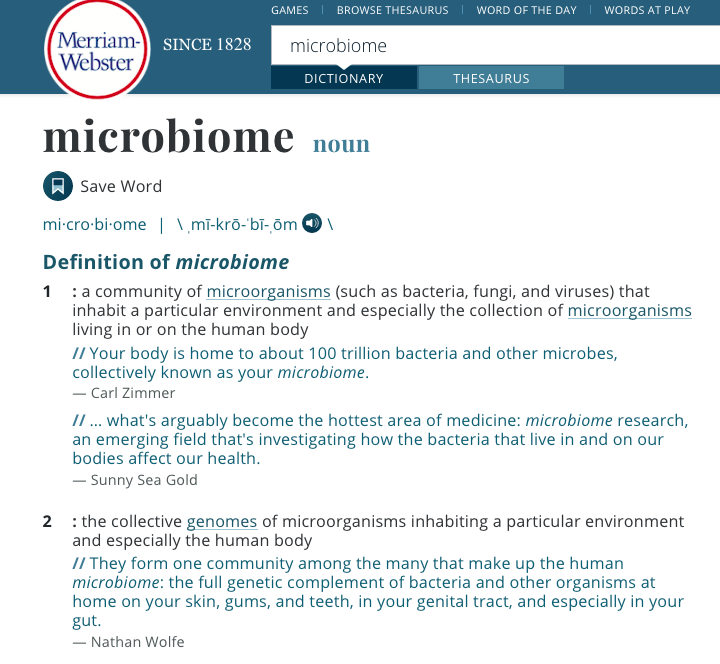Microbiome quick guide series: Microbiome definitions
The meaning of ‘microbiome’ and ‘microbiota’ is not always straightforward. Several definitions exist, and the meaning depends on the specific context—whether in scientific usage or everyday usage.
Definition of microbiome
As outlined in a 2015 paper by Marchesi and Ravel, scientists tend to use two different definitions of microbiome (pronounced ‘micro-BYE-owm’), depending on the context.
(1) Microbiome: “the entire habitat, including the microorganisms (bacteria, archaea, lower and higher eurkaryotes, and viruses), their genomes (i.e., genes), and the surrounding environmental conditions.”
This broad definition encompasses the entire habitat where microorganisms dwell, along with all of the microorganisms in that habitat.
It’s similar to referring to the rainforest biome, for example, which includes the land and all the big and small organisms that make it up.
(2) Microbiome: “the collection of genes and genomes of members of a microbiota.”
This narrower definition leaves out the names of the microorganisms, and refers only to the genetic information contained in those microorganisms—so it’s referring to the entire collection of genetic information in a community of microbes.
However, in everyday usage there is yet a third definition of this term.
(3) Microbiome: “a community of microorganisms (such as bacteria, fungi, and viruses) that inhabit a particular environment.”
So in this scenario, microbiome refers to the microbes themselves—which is technically the meaning of ‘microbiota’ (below). But this is what people usually mean when they say ‘microbiome’—as in a gut microbiome test or a gut microbiome study.
Note that when using the word ‘microbiome’ in a sentence, it’s possible to use the word with a definite or indefinite article, or without an article at all. So it’s possible to say ‘the microbiome‘ or ‘a microbiome’ or just ‘microbiome‘.
Definition of microbiota
In the 2015 paper mentioned above, scientists defined the microbiota (pronounced ‘micro-bye-OH-tuh’ or ‘micro-bye-AH-tuh’) as:
(1) Microbiota: “the assemblage of microorganisms present in a defined environment.”
This refers to the microorganisms themselves—so all the bacteria, archaea, and Eukaryotes (i.e. more complex microorganisms) in an environment like the gut. When most people say ‘microbiome’ they are technically referring to the ‘microbiota’, this community of microorganisms.
The phrase ‘members of a microbiota’ means specific categories of microorganisms in a microbiota. For example, strains of Bifidobacterium infantis might be present in a gut microbiome sample, so they would be called members of that gut microbiota.
The word microbiota can function as either singular or plural. So it’s possible to say ‘the microbiota is…’ or ‘the microbiota are…’ It’s becoming more common, however, to use ‘microbiotas’ for the plural of microbiota in scientific papers.
The term ‘microflora’
You might see the words ‘microflora’ or just ‘flora’ used in relation to the gut microbiota. ‘Flora’ derives from the Greek word for plant, and implies that there are microscopic plants in the gut. Because this is now known to be scientifically inaccurate (as many of the microorganisms that make up the gut microbiota are single-celled, unlike plants), this term is now more-or-less obsolete in the scientific literature.






